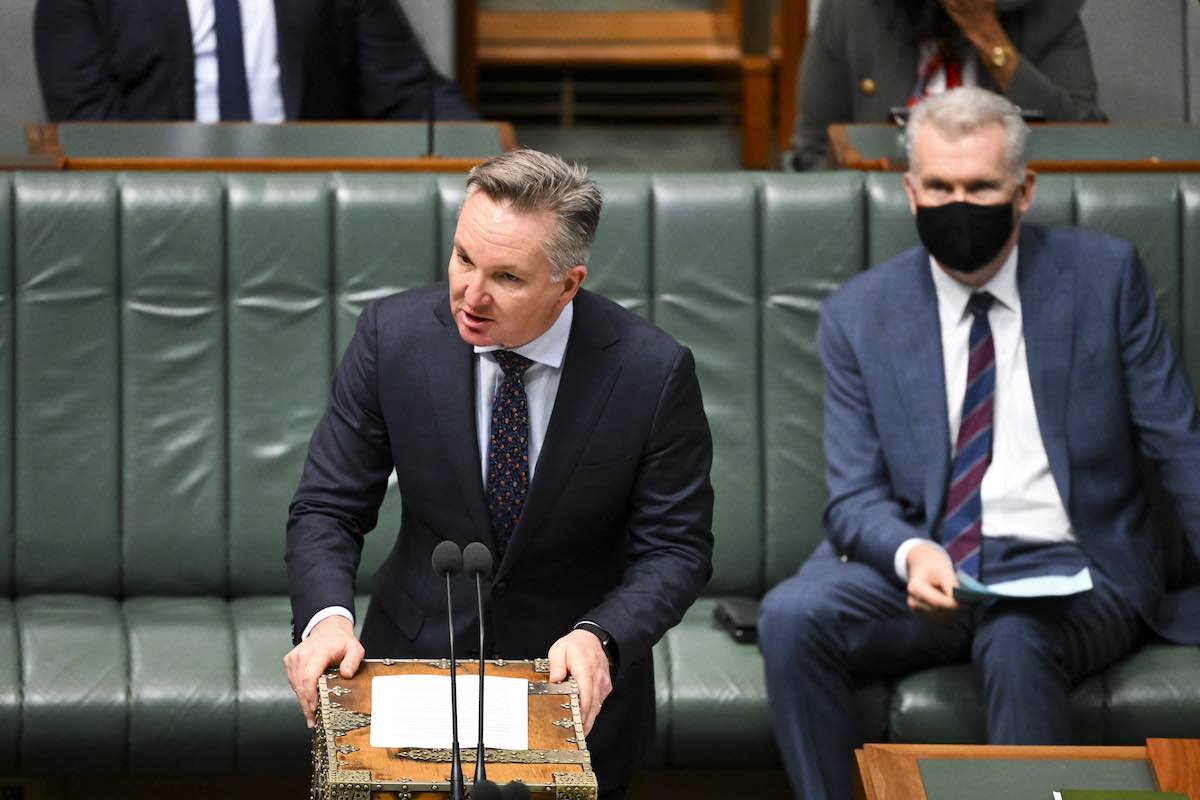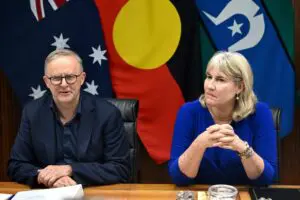Australia expects to beat its national emissions of a 43 per cent reduction by 2030, despite no decrease in emissions over the past year, according to climate and energy minister Chris Bowen.
Australia’s progress towards its legislated emissions reduction target was updated on Thursday in federal parliament with the delivery of the Albanese government’s first Annual Climate Change Statement.
The annual updates, a requirement of the Albanese government’s Climate Change Act, include the latest emissions projections and quarterly emissions update, alongside the latest advice from the independent Climate Change Authority.
Federal energy minister Chris Bowen says the first of these reports, coming just six months after the Albanese government was elected, shows it has lifted Australia’s emissions reduction outlook by a third in that time.
It puts the country on track to cut emissions by 40 per cent by 2030, up from the 30 per cent cut assumed under the Coalition, but it says policies not yet in place will change the trajectory to beat the 43 per cent target.

“As we have said repeatedly, we see 43 per cent as a floor, not a ceiling,” Bowen said in Parliament on Thursday.
“But the documents I am tabling today, including the advice from the Climate Change Authority, underlines just what a substantial effort this 43 per cent target requires.
“To achieve a 43 per cent reduction by 2030, and net zero by 2050, [the] decarbonisation rate needs to be at least 17 million tonnes of carbon per year – a 40 per cent increase.”
Bowen says he is confident that climate and renewables policies the Albanese government took to election, and is now working on implementing, will lift its result to at least 43 per cent by the targeted date.
He says the current emissions projections do not factor in some Powering Australia measures, the National Electric Vehicle Strategy, or additional commitments such as the National Energy Performance Strategy.
Emissions hold steady
According to the CCA report, Australia’s total greenhouse gas emissions for the 2021-22 period are estimated to have held steady at 487 Mt CO2-e – the same total as the previous financial year (to June 2021).
The report says the heaviest lifter on emissions reductions remains the electricity sector, which cut emissions by
6 Mt CO2-e over the year (Table 3), thanks to the continuing shift to wind and solar.

But, as has been the case in the past, the electricity sector achievements were “more than offset” by increases in stationary energy, agricultural and fugitive emissions (Figure 5).

Going forward, the report projects the stationary energy sector to be the largest single sector source of emissions by 2030, followed by the transport sector.
The CCA says meeting Australia’s 2030 target will mostly be achieved by deploying technologies that already exist – but it stresses, “the pace and scale of the rollout is now the question.”
In terms of large-scale renewables, alone, the CCA says generation needs to be deployed at “two to three times the rate of the previous decade,” alongside huge amounts of energy storage.
And to achieve this, supply chains, workforce capacity and project approval timelines will all need to “improve dramatically,” the report says.
Climate change a “lived reality”
Speaking in parliament, Bowen stressed that his government was aware of the urgency of the climate task ahead and determined to be transparent about its progress.
“There is much more to do, and we accept the advice from the Climate Change Authority that this will need an ongoing focus.
“Climate change has moved from a theory… To a prediction… To a lived reality,” he said.
“The truth is that no Australian is spared from the impact of climate change – from the regions to the cities. Not acting would be an unforgivable act of intergenerational negligence.
“For decades, Australians were told by some that action on climate change would cost jobs. This was always a lie. It has never been more of a lie than today,” Bowen added.
“But Australians know better. We can have electric vehicles AND enjoy the weekend. We can reduce methane AND enjoy barbecues. Renewables are the answer to this energy crisis, not the cause.”
Moving beyond renewables
Of course, it will take a lot more than the shift to a renewable electricity supply to meet Australia’s share of the climate task – as the CCA report advises, and Bowen appears to have taken this on board.
“In fact, industrial emitters are projected to overtake electricity generators as Australia’s leading source of emissions,” the minister said.
“We won’t reduce our emissions unless we reduce them in our top 200 industrial emitters.
“And so, we need to reform the Safeguard Mechanism, which governs the emissions of our biggest industrial emitters.”
The beginnings of this process got properly underway just this week, with legislation tabled on Wednesday as the first part of a process to establish the new safeguard mechanism credits (SMCs), which will reward high polluting facilities for reducing their emissions below a baseline.
The design of the new system is expected to be released in December, outlining expectations for how it’ll work, including methodologies for creating baselines, possible compensation for trade exposed industries, and how baselines will be lowered over time.










